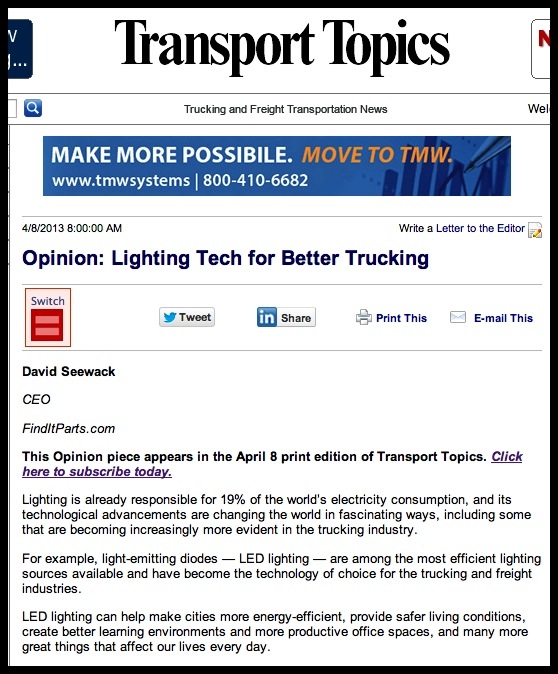David Seewack Opinion Section of Transport Topics: "Lighting Tech for Better Trucking"

Lighting Technology Has Improved the Trucking Industry
David Seewack, CEO of FindItParts.com
Did you know that lighting is responsible for 19% of the world's electricity consumption? The technological advancements in lighting are changing the world in so many fascinating ways and it's becoming increasingly more evident in the trucking industry.
LED lighting is among the most efficient lighting sources available and has become the technology of choice for the trucking and freight industries. LED lighting can help make cities more energy efficient, provide safer living conditions, create better learning environments, more productive office spaces, and many more great things that impact our lives everyday.
Now how is LED lighting impact the trucking industry? Good question! Reducing the carbon footprint of fleets can have a material impact on the environment, business bottom lines and the safety of drivers. Here are some reasons why upgrading your lighting is a great investment.
1. There's data...and then There's usable data
LED lighting has the ability to dramatically increase your fleet's productivity. The benefits of enhanced lighting on your fleets can result in less downtime, better driver visibility, decreased maintenance costs and fewer accidents.
Fram's famous marketing slogan "You can pay me now, or pay me later" really hits home when it comes to upgrading to LED lights. Sure, there are countless numbers of low cost incandescent lights in the market, but the hidden cost of not upgrading can really sneak up on you. Check out this example from Tom Draper of Grote Industries, "Let's take a look at a medium sized fleet that uses 100% incandescent stop/tail/turn lamps. A 2,000 trailer fleet has 8,000 stop/tail/turn lamps in circulation. At a 3.5 year average life expectancy per bulb, divided by 365 days per year, that fleet will experience approximately 6 STT failures per day, which amazingly enough creates more than 2,000 downtime episodes per year. And before all those downtime episodes, there are more than 2,000 chances for an on-the road lighting violation, which could result in a parked truck waiting for hours for a $150 roadside service call." And then, of course, there's the hidden fee of the service that isn't being performed or the load that isn't being delivered. There was a time when measuring savings was only possible by simply comparing old cost vs new cost (Hard Savings). Grote's example show's how a fleet can not only measure this savings, but more importantly, quantify it (Soft Savings).
2. Avoid Lighting Infractions/Fines
Lighting infractions are one of the leading reasons a fleet's maintenance score can deteriorate. Lighting violations accounted for four of the top eleven violation categories or 22.3% of all violations in 2011. A high-quality lighting strategy will help improve CSA scores by lowering the number of unexpected lighting incidents incurred in normal everyday operations.
3. Minimize Equipment Downtime
As with all fleets, unplanned equipment downtime is a big concern. The costs associated with delayed deliveries and lost loads are far more costly than the money saved in buying inexpensive lighting.
The very low current consumption and superior illumination in LED lighting is coupled with a life span that can exceed 50 years of operation for a traditional 18-wheeler covering 100-200K miles per year. Imagine the long-term benefits of having safe, reliable lights without the worry of violations, reduced visibility or downtime for maintenance.
4. Increase Drive Safety
The increasing shortage of truck drivers has made retaining current drivers and attracting younger drivers absolutely critical. One very important concern for drivers has been increasing safety standards. LED lighting can have a material impact on improving standards for drivers, as LED lighting has proven to decrease accidents and improve overall driver safety.
5. Save Money
With any business, the ability to effectively manage expenses is important. In the trucking industry it's absolutely critical. The expenses associated with fleet downtime, accidents, maintenance and other related issues can be extremely costly. LED lighting provides savings due to their longevity, increased driver visibility, and low maintenance levels.
Fleets that try to save money on initial LED lamp purchases inevitably spend more money over the life of their equipment. That's because all LED lamps are not alike. Here are some guidelines for making your big purchase and doing it right.
- First, the LED lamp chosen should be of the highest quality, as not all lamps are created equal. Remember to consult an expert, as there are many factors to consider including design sophistication, ruggedness both of structure and electronics, protection from voltage spikes and electromagnetic interference, lens design, mounting design, etc.
- The quality and life expectancy of LED diodes vary significantly. Low quality LEDs start to dim unevenly or just burn out, which can be very problematic over time. In addition, the electronics within inexpensive lamps may not last due to vibration, corrosion, and the stress of the highway environment.
- Lastly, entire lighting systems provide the best long-term solutions for your investment. If the LED lamp technology can outlast the equipment it is installed on, then you have a potential problem.
Overall, LED lighting is revolutionizing the trucking industry and helping provide a safer, more profitable environment for fleet owners nationwide.
Presented by: FindItParts.com is the leading e-commerce solution for heavy-duty trucks parts with over 2.5 million parts from over 1,200 manufacturers and OEM's.
FinditParts.com enables customers to quickly and easily find the part they need for heavy-duty truck, medium-duty auto, transit, school bus, light duty and medium duty vehicles, trailers, forklifts, off-road, & agriculture vehicles around the world.